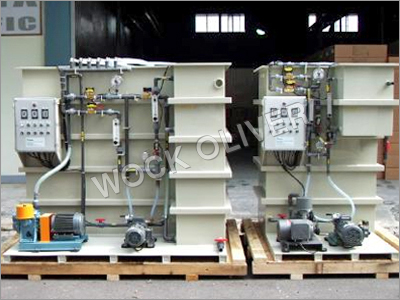
Membrane Bioreacter MBR
Product Details:
X
Product Description
Membrane Bioreacter MBR
Membrane technology has led to a revolutionary new concept in wastewater treatment. Membranes act as a barrier to bacteria and suspended solids to produce a low turbidity treatment plant effluent with very low bacteria counts.
MBR is the combination of a membrane process like microfiltration or ultra filtration with a suspended growth bioreactor. This very compact arrangement produces a MF/UF quality effluent suitable for reuse applications or as a high quality feed water source for Reverse Osmosis treatment
Advantages
MBRs operate at solid retention times (SRT) as low as 10–20 days, resulting in more manageable mixed liquor suspended solids (MLSS) levels (10-15 g/L). Thanks to these new operating conditions, the oxygen transfer and the pumping cost in the MBR have decreased and overall maintenance has been simplified. Typical hydraulic retention times (HRT) range between 3 and 10 hours. In terms of membrane configurations, mainly hollow fibre and flat sheet membranes are applied for MBR applications.
Submerged Membrane Bioreactor MBR
Compact package plant consists of a bioreactor and a filtration tank with MBR module and Operation Control Unit(OCU). The submerged UF membranes retain all solids, bacteria and germs bigger than approx. 0.042m separation size and guarantee a maximum effluent quality. It is ideally suited for communities that desire a high quality water system with a small footprint, minimal installation and nominal operator attendance. The membrane filtration system, along with all ancillary equipment included the permeate/back flush filtrate tank, air supply system, CIP system, instrumentation package and integral controls are supplied.
Membrane technology has led to a revolutionary new concept in wastewater treatment. Membranes act as a barrier to bacteria and suspended solids to produce a low turbidity treatment plant effluent with very low bacteria counts.
MBR is the combination of a membrane process like microfiltration or ultra filtration with a suspended growth bioreactor. This very compact arrangement produces a MF/UF quality effluent suitable for reuse applications or as a high quality feed water source for Reverse Osmosis treatment
Advantages
- Reduced plant footprint as Secondary clarifiers and tertiary filtration are eliminated
- Footprint can be further reduced because other process units (digesters or UV disinfection and aeration basin volume) can also be eliminated/ minimized
- Long sludge age, hence low sludge production
- Produces a MF/UF quality effluent suitable for reuse applications
- Can be housed in a building
- Reduced sludge dewatering cost
- Municipal wastewater for high quality outlet water
- For re-cycling systems
- Wastewater from numerous industrial sources such as paper mills, beverage ingredient processors, slaughterhouses, food processors, chemical plants, tank truck cleaning operations, etc.
MBRs operate at solid retention times (SRT) as low as 10–20 days, resulting in more manageable mixed liquor suspended solids (MLSS) levels (10-15 g/L). Thanks to these new operating conditions, the oxygen transfer and the pumping cost in the MBR have decreased and overall maintenance has been simplified. Typical hydraulic retention times (HRT) range between 3 and 10 hours. In terms of membrane configurations, mainly hollow fibre and flat sheet membranes are applied for MBR applications.
Submerged Membrane Bioreactor MBR
Compact package plant consists of a bioreactor and a filtration tank with MBR module and Operation Control Unit(OCU). The submerged UF membranes retain all solids, bacteria and germs bigger than approx. 0.042m separation size and guarantee a maximum effluent quality. It is ideally suited for communities that desire a high quality water system with a small footprint, minimal installation and nominal operator attendance. The membrane filtration system, along with all ancillary equipment included the permeate/back flush filtrate tank, air supply system, CIP system, instrumentation package and integral controls are supplied.
WOCK OLIVER
No. 321-322, Sukhana Enclave, Near Sec-5,Chandigarh - 160103, India
|
|
|
|
 |
WOCK OLIVER
All Rights Reserved.(Terms of Use) Developed and Managed by Infocom Network Private Limited. |

